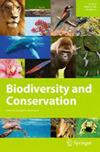Interplay between pond size and matrix extent drives odonate diversity patterns in a fragmented landscape
IF 3
2区 环境科学与生态学
Q1 BIODIVERSITY CONSERVATION
引用次数: 0
Abstract
Abstract Landscape fragmentation impacts freshwater habitats and their quality, affecting aquatic insect assemblages. Adjacent terrestrial areas are important secondary habitats where amphibiotic insects mature, feed, find mates, and move to locate aquatic breeding habitats. Using a factorial design with 27 small and large ponds within small and large natural patches in an exotic tree plantation-fragmented landscape of South Africa, and odonates as model organisms, we investigated (1) how pond size/natural terrestrial patch size interaction affects odonate diversity patterns versus habitat quality variables, and (2) determined whether anisopterans and zygopterans respond differently to landscape fragmentation. Species richness was similar among ponds. However, odonate abundance was highest in large ponds regardless of natural terrestrial patch size. Zygopteran functional richness and diversity was driven by pond and natural patch size, suggesting that zygopterans are sensitive to landscape fragmentation. In contrast, anisopterans were more resilient to fragmentation and more likely to select suitable habitats following water chemistry and vegetation characteristics. Overall, large ponds were occupied by different odonate assemblages compared to small ponds, and occupancy was strongly associated with mobility traits. These findings emphasize that ponds in both small and large natural terrestrial patches have conservation value. A pondscape that represents various pond sizes is important for maintaining regional odonate diversity. Pond conservation needs to be considered in the wider terrestrial context, which host a range of important secondary habitats. Adjacent natural terrestrial habitats also connect nearby aquatic habitats, which enable insects to move across the landscape in response to natural and artificial drivers.

池塘大小和基质范围之间的相互作用驱动了破碎景观的多样性格局
景观破碎化影响淡水生境及其质量,影响水生昆虫群落。邻近的陆地区域是两栖昆虫成熟、觅食、寻找配偶和迁移到水生繁殖栖息地的重要次级栖息地。采用因子设计,在南非外来人工林破碎化景观的大小自然斑块内设置27个大小池塘,并以齿形动物为模式生物,研究了:(1)池塘大小/自然陆地斑块大小相互作用如何影响齿形动物多样性模式和栖息地质量变量;(2)确定异翅目动物和钩翅目动物对景观破碎化的反应是否不同。不同池塘的物种丰富度相似。然而,无论天然陆地斑块大小如何,大型池塘的有机物丰度最高。塘面积和自然斑块大小对翼龙的功能丰富度和多样性具有驱动作用,表明翼龙对景观破碎化较为敏感。相反,异翅目动物对破碎化更有弹性,更有可能根据水化学和植被特征选择合适的栖息地。总体而言,与小池塘相比,大池塘的有机物组合占有不同,并且占有与流动性特征密切相关。这些发现强调了大小天然陆地斑块的池塘都具有保护价值。代表不同池塘大小的池塘景观对于维持区域生物多样性非常重要。池塘保护需要在更广泛的陆地环境中考虑,它拥有一系列重要的次要栖息地。邻近的自然陆地栖息地也连接着附近的水生栖息地,这使得昆虫能够根据自然和人工驱动因素在景观中移动。
本文章由计算机程序翻译,如有差异,请以英文原文为准。
求助全文
约1分钟内获得全文
求助全文
来源期刊

Biodiversity and Conservation
环境科学-环境科学
CiteScore
6.20
自引率
5.90%
发文量
153
审稿时长
9-18 weeks
期刊介绍:
Biodiversity and Conservation is an international journal that publishes articles on all aspects of biological diversity-its description, analysis and conservation, and its controlled rational use by humankind. The scope of Biodiversity and Conservation is wide and multidisciplinary, and embraces all life-forms.
The journal presents research papers, as well as editorials, comments and research notes on biodiversity and conservation, and contributions dealing with the practicalities of conservation management, economic, social and political issues. The journal provides a forum for examining conflicts between sustainable development and human dependence on biodiversity in agriculture, environmental management and biotechnology, and encourages contributions from developing countries to promote broad global perspectives on matters of biodiversity and conservation.
 求助内容:
求助内容: 应助结果提醒方式:
应助结果提醒方式:


